Xuanyi Dong
DoReMi: Optimizing Data Mixtures Speeds Up Language Model Pretraining
May 24, 2023Abstract:The mixture proportions of pretraining data domains (e.g., Wikipedia, books, web text) greatly affect language model (LM) performance. In this paper, we propose Domain Reweighting with Minimax Optimization (DoReMi), which first trains a small proxy model using group distributionally robust optimization (Group DRO) over domains to produce domain weights (mixture proportions) without knowledge of downstream tasks. We then resample a dataset with these domain weights and train a larger, full-sized model. In our experiments, we use DoReMi on a 280M-parameter proxy model to find domain weights for training an 8B-parameter model (30x larger) more efficiently. On The Pile, DoReMi improves perplexity across all domains, even when it downweights a domain. DoReMi improves average few-shot downstream accuracy by 6.5% points over a baseline model trained using The Pile's default domain weights and reaches the baseline accuracy with 2.6x fewer training steps. On the GLaM dataset, DoReMi, which has no knowledge of downstream tasks, even matches the performance of using domain weights tuned on downstream tasks.
Symbolic Discovery of Optimization Algorithms
Feb 17, 2023



Abstract:We present a method to formulate algorithm discovery as program search, and apply it to discover optimization algorithms for deep neural network training. We leverage efficient search techniques to explore an infinite and sparse program space. To bridge the large generalization gap between proxy and target tasks, we also introduce program selection and simplification strategies. Our method discovers a simple and effective optimization algorithm, $\textbf{Lion}$ ($\textit{Evo$\textbf{L}$ved S$\textbf{i}$gn M$\textbf{o}$me$\textbf{n}$tum}$). It is more memory-efficient than Adam as it only keeps track of the momentum. Different from adaptive optimizers, its update has the same magnitude for each parameter calculated through the sign operation. We compare Lion with widely used optimizers, such as Adam and Adafactor, for training a variety of models on different tasks. On image classification, Lion boosts the accuracy of ViT by up to 2% on ImageNet and saves up to 5x the pre-training compute on JFT. On vision-language contrastive learning, we achieve 88.3% $\textit{zero-shot}$ and 91.1% $\textit{fine-tuning}$ accuracy on ImageNet, surpassing the previous best results by 2% and 0.1%, respectively. On diffusion models, Lion outperforms Adam by achieving a better FID score and reducing the training compute by up to 2.3x. For autoregressive, masked language modeling, and fine-tuning, Lion exhibits a similar or better performance compared to Adam. Our analysis of Lion reveals that its performance gain grows with the training batch size. It also requires a smaller learning rate than Adam due to the larger norm of the update produced by the sign function. Additionally, we examine the limitations of Lion and identify scenarios where its improvements are small or not statistically significant. The implementation of Lion is publicly available.
PyGlove: Efficiently Exchanging ML Ideas as Code
Feb 03, 2023



Abstract:The increasing complexity and scale of machine learning (ML) has led to the need for more efficient collaboration among multiple teams. For example, when a research team invents a new architecture like "ResNet," it is desirable for multiple engineering teams to adopt it. However, the effort required for each team to study and understand the invention does not scale well with the number of teams or inventions. In this paper, we present an extension of our PyGlove library to easily and scalably share ML ideas. PyGlove represents ideas as symbolic rule-based patches, enabling researchers to write down the rules for models they have not seen. For example, an inventor can write rules that will "add skip-connections." This permits a network effect among teams: at once, any team can issue patches to all other teams. Such a network effect allows users to quickly surmount the cost of adopting PyGlove by writing less code quicker, providing a benefit that scales with time. We describe the new paradigm of organizing ML through symbolic patches and compare it to existing approaches. We also perform a case study of a large codebase where PyGlove led to an 80% reduction in the number of lines of code.
Triformer: Triangular, Variable-Specific Attentions for Long Sequence Multivariate Time Series Forecasting--Full Version
Apr 28, 2022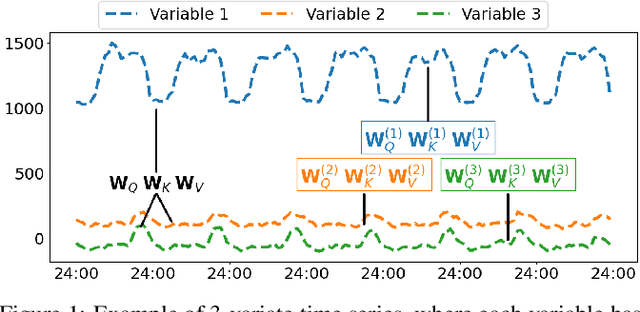
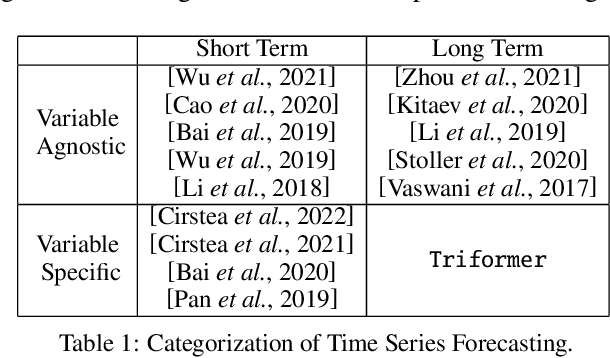

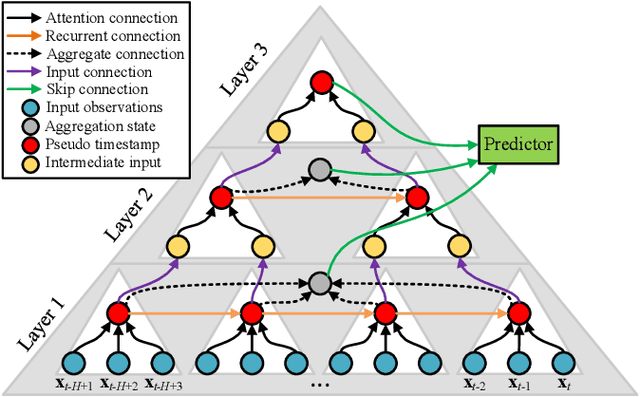
Abstract:A variety of real-world applications rely on far future information to make decisions, thus calling for efficient and accurate long sequence multivariate time series forecasting. While recent attention-based forecasting models show strong abilities in capturing long-term dependencies, they still suffer from two key limitations. First, canonical self attention has a quadratic complexity w.r.t. the input time series length, thus falling short in efficiency. Second, different variables' time series often have distinct temporal dynamics, which existing studies fail to capture, as they use the same model parameter space, e.g., projection matrices, for all variables' time series, thus falling short in accuracy. To ensure high efficiency and accuracy, we propose Triformer, a triangular, variable-specific attention. (i) Linear complexity: we introduce a novel patch attention with linear complexity. When stacking multiple layers of the patch attentions, a triangular structure is proposed such that the layer sizes shrink exponentially, thus maintaining linear complexity. (ii) Variable-specific parameters: we propose a light-weight method to enable distinct sets of model parameters for different variables' time series to enhance accuracy without compromising efficiency and memory usage. Strong empirical evidence on four datasets from multiple domains justifies our design choices, and it demonstrates that Triformer outperforms state-of-the-art methods w.r.t. both accuracy and efficiency. This is an extended version of "Triformer: Triangular, Variable-Specific Attentions for Long Sequence Multivariate Time Series Forecasting", to appear in IJCAI 2022 [Cirstea et al., 2022a], including additional experimental results.
Automated Deep Learning: Neural Architecture Search Is Not the End
Jan 21, 2022
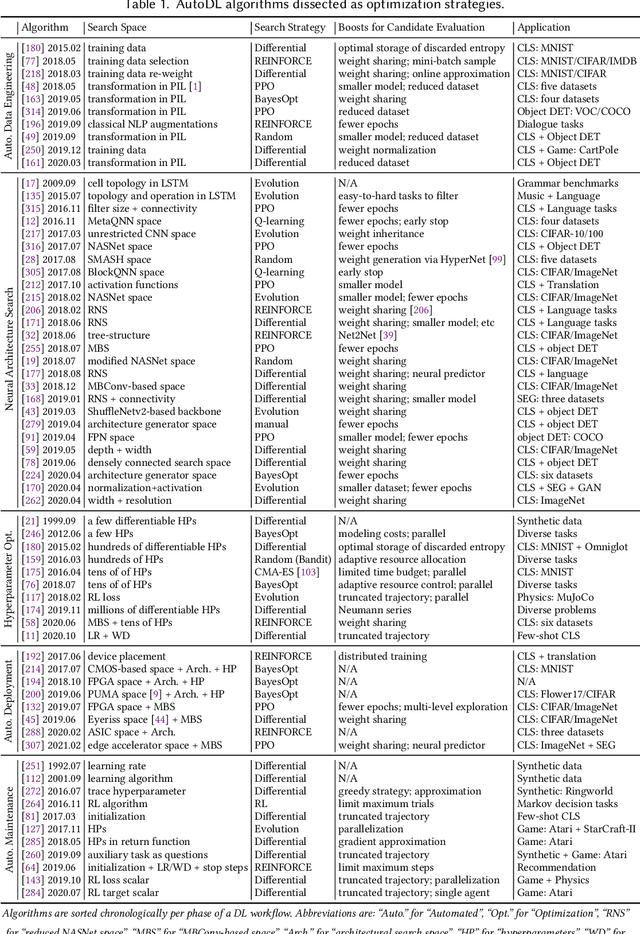
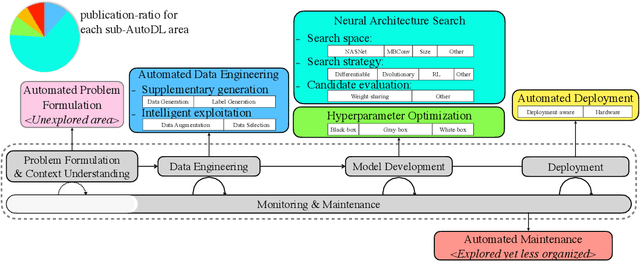

Abstract:Deep learning (DL) has proven to be a highly effective approach for developing models in diverse contexts, including visual perception, speech recognition, and machine translation. However, the end-to-end process for applying DL is not trivial. It requires grappling with problem formulation and context understanding, data engineering, model development, deployment, continuous monitoring and maintenance, and so on. Moreover, each of these steps typically relies heavily on humans, in terms of both knowledge and interactions, which impedes the further advancement and democratization of DL. Consequently, in response to these issues, a new field has emerged over the last few years: automated deep learning (AutoDL). This endeavor seeks to minimize the need for human involvement and is best known for its achievements in neural architecture search (NAS), a topic that has been the focus of several surveys. That stated, NAS is not the be-all and end-all of AutoDL. Accordingly, this review adopts an overarching perspective, examining research efforts into automation across the entirety of an archetypal DL workflow. In so doing, this work also proposes a comprehensive set of ten criteria by which to assess existing work in both individual publications and broader research areas. These criteria are: novelty, solution quality, efficiency, stability, interpretability, reproducibility, engineering quality, scalability, generalizability, and eco-friendliness. Thus, ultimately, this review provides an evaluative overview of AutoDL in the early 2020s, identifying where future opportunities for progress may exist.
Recognizing Vector Graphics without Rasterization
Nov 12, 2021
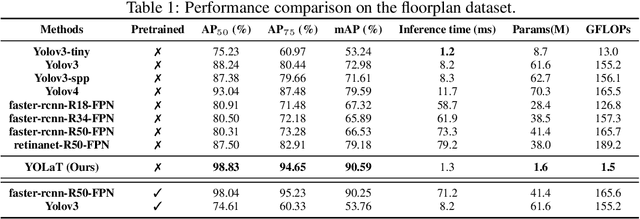

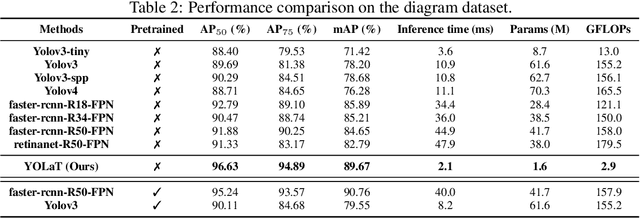
Abstract:In this paper, we consider a different data format for images: vector graphics. In contrast to raster graphics which are widely used in image recognition, vector graphics can be scaled up or down into any resolution without aliasing or information loss, due to the analytic representation of the primitives in the document. Furthermore, vector graphics are able to give extra structural information on how low-level elements group together to form high level shapes or structures. These merits of graphic vectors have not been fully leveraged in existing methods. To explore this data format, we target on the fundamental recognition tasks: object localization and classification. We propose an efficient CNN-free pipeline that does not render the graphic into pixels (i.e. rasterization), and takes textual document of the vector graphics as input, called YOLaT (You Only Look at Text). YOLaT builds multi-graphs to model the structural and spatial information in vector graphics, and a dual-stream graph neural network is proposed to detect objects from the graph. Our experiments show that by directly operating on vector graphics, YOLaT out-performs raster-graphic based object detection baselines in terms of both average precision and efficiency.
Full-Cycle Energy Consumption Benchmark for Low-Carbon Computer Vision
Aug 30, 2021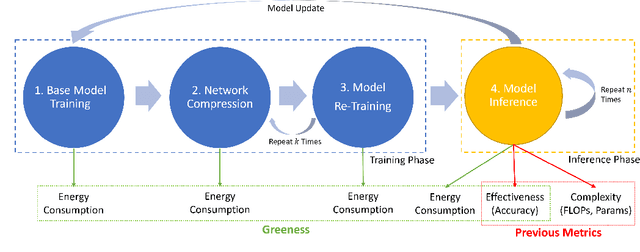


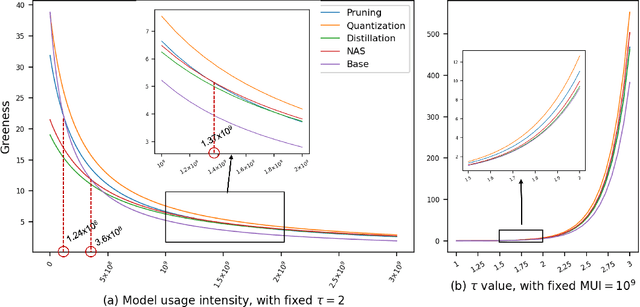
Abstract:The energy consumption of deep learning models is increasing at a breathtaking rate, which raises concerns due to potential negative effects on carbon neutrality in the context of global warming and climate change. With the progress of efficient deep learning techniques, e.g., model compression, researchers can obtain efficient models with fewer parameters and smaller latency. However, most of the existing efficient deep learning methods do not explicitly consider energy consumption as a key performance indicator. Furthermore, existing methods mostly focus on the inference costs of the resulting efficient models, but neglect the notable energy consumption throughout the entire life cycle of the algorithm. In this paper, we present the first large-scale energy consumption benchmark for efficient computer vision models, where a new metric is proposed to explicitly evaluate the full-cycle energy consumption under different model usage intensity. The benchmark can provide insights for low carbon emission when selecting efficient deep learning algorithms in different model usage scenarios.
Rethinking Co-design of Neural Architectures and Hardware Accelerators
Feb 17, 2021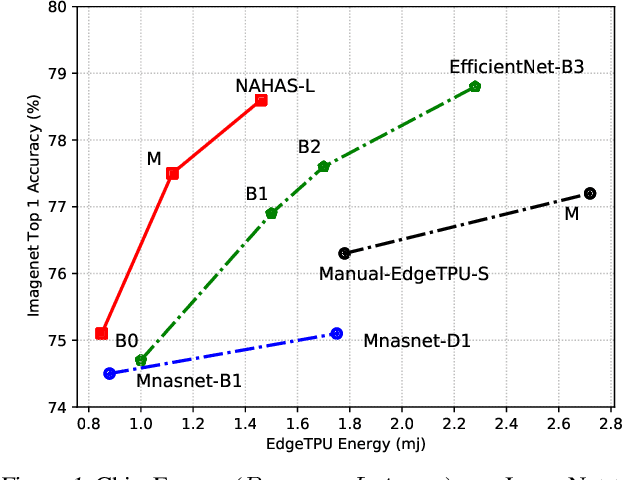
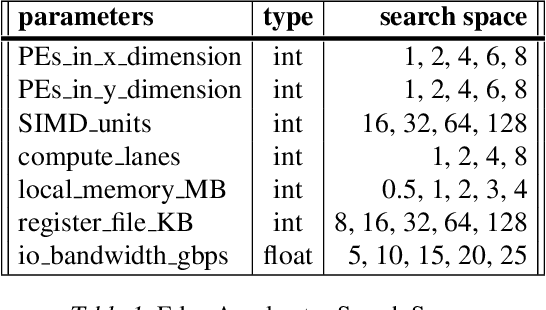
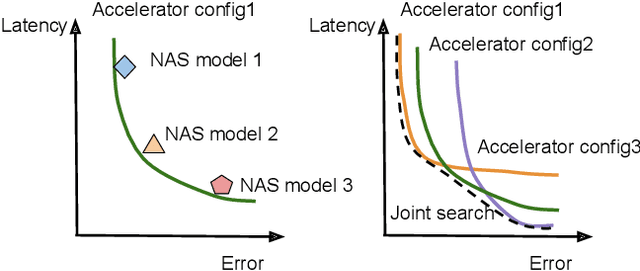
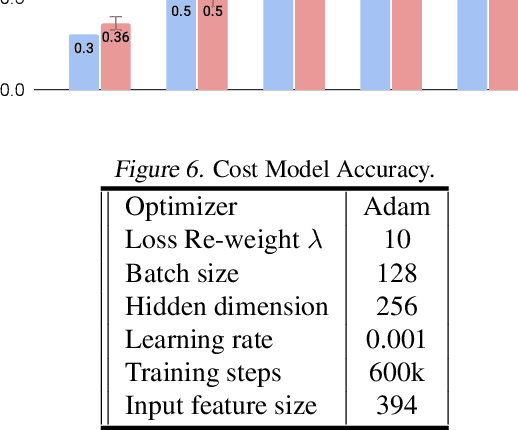
Abstract:Neural architectures and hardware accelerators have been two driving forces for the progress in deep learning. Previous works typically attempt to optimize hardware given a fixed model architecture or model architecture given fixed hardware. And the dominant hardware architecture explored in this prior work is FPGAs. In our work, we target the optimization of hardware and software configurations on an industry-standard edge accelerator. We systematically study the importance and strategies of co-designing neural architectures and hardware accelerators. We make three observations: 1) the software search space has to be customized to fully leverage the targeted hardware architecture, 2) the search for the model architecture and hardware architecture should be done jointly to achieve the best of both worlds, and 3) different use cases lead to very different search outcomes. Our experiments show that the joint search method consistently outperforms previous platform-aware neural architecture search, manually crafted models, and the state-of-the-art EfficientNet on all latency targets by around 1% on ImageNet top-1 accuracy. Our method can reduce energy consumption of an edge accelerator by up to 2x under the same accuracy constraint, when co-adapting the model architecture and hardware accelerator configurations.
Isometric Propagation Network for Generalized Zero-shot Learning
Feb 03, 2021


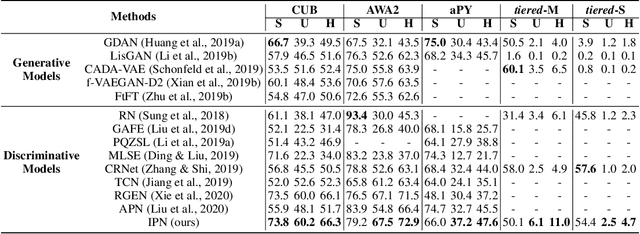
Abstract:Zero-shot learning (ZSL) aims to classify images of an unseen class only based on a few attributes describing that class but no access to any training sample. A popular strategy is to learn a mapping between the semantic space of class attributes and the visual space of images based on the seen classes and their data. Thus, an unseen class image can be ideally mapped to its corresponding class attributes. The key challenge is how to align the representations in the two spaces. For most ZSL settings, the attributes for each seen/unseen class are only represented by a vector while the seen-class data provide much more information. Thus, the imbalanced supervision from the semantic and the visual space can make the learned mapping easily overfitting to the seen classes. To resolve this problem, we propose Isometric Propagation Network (IPN), which learns to strengthen the relation between classes within each space and align the class dependency in the two spaces. Specifically, IPN learns to propagate the class representations on an auto-generated graph within each space. In contrast to only aligning the resulted static representation, we regularize the two dynamic propagation procedures to be isometric in terms of the two graphs' edge weights per step by minimizing a consistency loss between them. IPN achieves state-of-the-art performance on three popular ZSL benchmarks. To evaluate the generalization capability of IPN, we further build two larger benchmarks with more diverse unseen classes and demonstrate the advantages of IPN on them.
Supervision by Registration and Triangulation for Landmark Detection
Jan 25, 2021
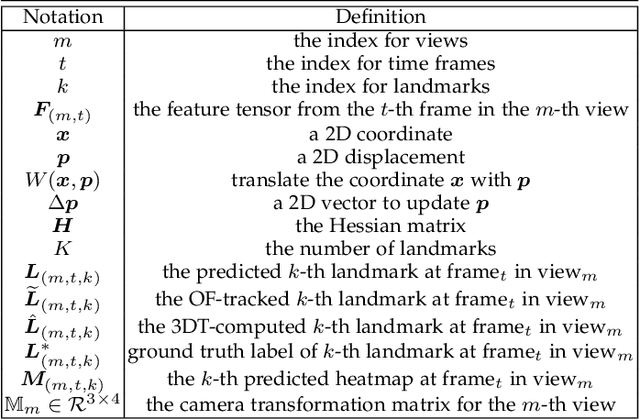

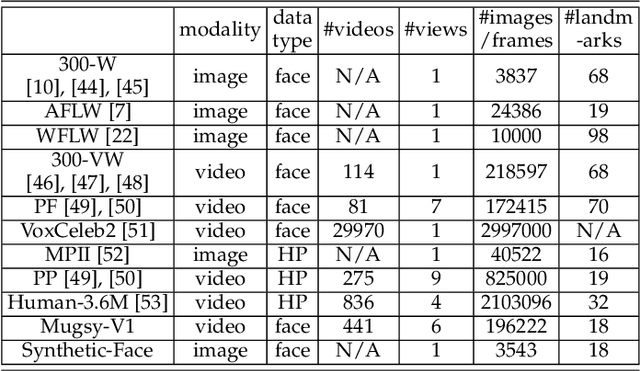
Abstract:We present Supervision by Registration and Triangulation (SRT), an unsupervised approach that utilizes unlabeled multi-view video to improve the accuracy and precision of landmark detectors. Being able to utilize unlabeled data enables our detectors to learn from massive amounts of unlabeled data freely available and not be limited by the quality and quantity of manual human annotations. To utilize unlabeled data, there are two key observations: (1) the detections of the same landmark in adjacent frames should be coherent with registration, i.e., optical flow. (2) the detections of the same landmark in multiple synchronized and geometrically calibrated views should correspond to a single 3D point, i.e., multi-view consistency. Registration and multi-view consistency are sources of supervision that do not require manual labeling, thus it can be leveraged to augment existing training data during detector training. End-to-end training is made possible by differentiable registration and 3D triangulation modules. Experiments with 11 datasets and a newly proposed metric to measure precision demonstrate accuracy and precision improvements in landmark detection on both images and video. Code is available at https://github.com/D-X-Y/landmark-detection.
 Add to Chrome
Add to Chrome Add to Firefox
Add to Firefox Add to Edge
Add to Edge